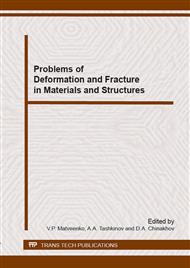[1]
McDowell D.L., Internal state variable theory, in: S. Yip (Ed. ), Handbook of Materials Modeling, Springer, 2005, p.1151–1169.
DOI: 10.1007/978-1-4020-3286-8_58
Google Scholar
[2]
Trusov P.V., Shveykin A.I., Nechaeva E.S., Volegov P.S., Multilevel models of inelastic deformation of materials and their application for description of internal structure evolution, Physical Mesomechanics. 15 (3-4) (2012) 155-175.
DOI: 10.1134/s1029959912020038
Google Scholar
[3]
Habraken A., Modelling the plastic anisotropy of metals, Arch. Comput. Meth. Engng. 11 (1) (2004) 3-96.
Google Scholar
[4]
Van Houtte P., Crystal plasticity based modelling of deformation textures, in: Haldar A., Suwas S., Bhattacharjee D. (Eds. ), Microstructure and Texture in Steels, Springer, pp.209-224.
DOI: 10.1007/978-1-84882-454-6_12
Google Scholar
[5]
Horstemeyer M.F., Multiscale modeling: a review, in: Leszczynski J.,. Shukla M. K (Eds. ), Practical Aspects of Computational Chemistry, Springer Science Business Media B.V., 2009, p.87–135.
DOI: 10.1007/978-90-481-2687-3_4
Google Scholar
[6]
McDowell D.L., A perspective on trends in multiscale plasticity, Int. J. Plast. 26 (9) (2010), pp.1280-3009.
Google Scholar
[7]
Van Houtte P., Delannay L., Samajdar I., Quantitive prediction of cold rolling textures in low-carbon steel by means of the LAMEL models, Text. Microstruct. 31 (1999) 109–149.
DOI: 10.1155/tsm.31.109
Google Scholar
[8]
Balasubramanian S., Anand L., Elasto-viscoplastic constitutive equations for polycrystalline fcc materials at low homologous temperatures, J. Mech. Phys. Solids. 50 (2002) 101–126.
DOI: 10.1016/s0022-5096(01)00022-9
Google Scholar
[9]
Anand L., Single-crystal elasto-viscoplasticity: application to texture evolution in polycrystalline metals at large strains, Comput. Meth. Appl. Mech. Eng. 193 (2004) 5359–5383.
DOI: 10.1016/j.cma.2003.12.068
Google Scholar
[10]
Trusov P.V., Volegov P.S., Shveykin A.I., Multilevel model of inelastic deformation of FCC polycrystalline with description of structure evolution, Comput. Mater. Sc. 79 (2013) 429-441.
DOI: 10.1016/j.commatsci.2013.06.037
Google Scholar
[11]
Kondratev N.S., Trusov P.V., Description of hardening slip systems due to the boundaries of the crystallines in a polycrystalline aggregate, PNRPU Mechanics Bulletin, 3 (2012) 78–97.
Google Scholar
[12]
Benallal A., Marquis D., Constitutive equations for nonproportional cyclic elastoviscoplasticity, J. Eng. Mater. Technol. 109 (1988) 326-336.
DOI: 10.1115/1.3225985
Google Scholar


